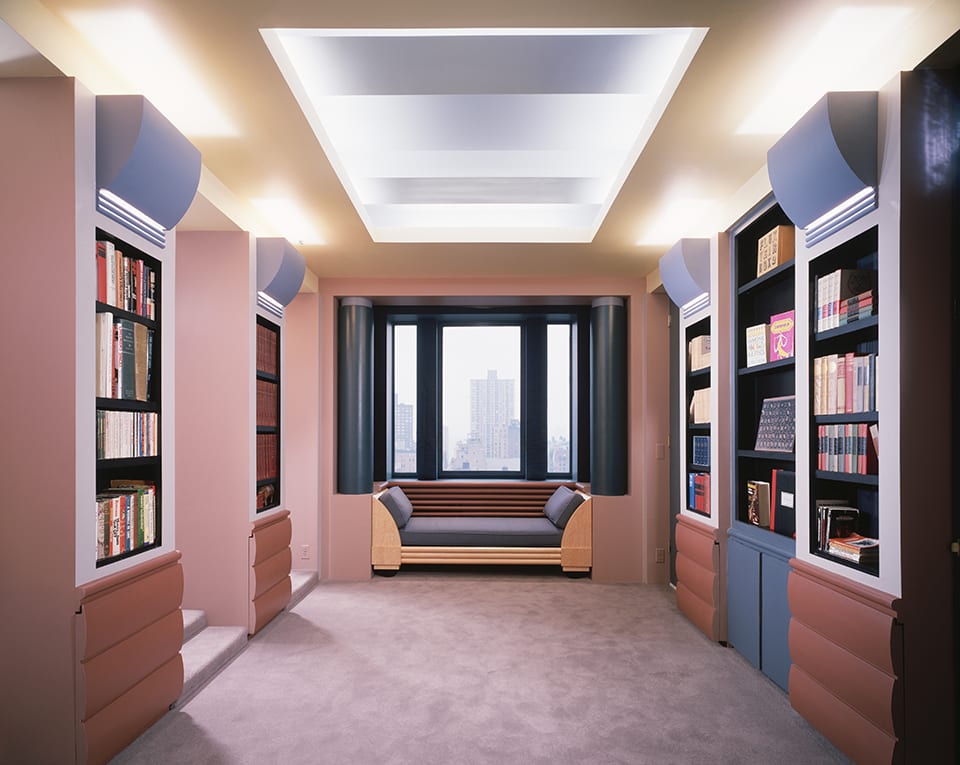A monumental show spans the last century of design, examining changing interiors and what they indicate about how society lives, works and consumes.
“Today, interior design sustains a giant, global economy of furniture, textiles and decoration. Both past and present trends feed an entire branch of the media, including magazines, television programming, blogs and social media channels. However, the interior is increasingly lacking in serious discourse. It is time to review the design of our homes.”
Houses are an expression of how we live – from everyday routines to work, rest, entertainment and well-being. They also offer private locations for dreaming, aspiring, organising, recuperating, archiving and collecting. Homes provide storage for what we deem most important, but they are also indicative of the outside world and its wider societal shifts. Where the human population becomes increasingly disconnected and more technologically dependent, homes are following suit through the introduction of smart surveillance, thermostats triggered by voice recognition and Bluetooth technology that collects data throughout the day.
Vitra Design Museum, Weil am Rhein, recently opened Home Stories – a show that initiates a conversation about contemporary interiors and their evolution. The exhibition explores the subject of private versus public through 20 case studies from the last 100 years, including groundbreaking principles from key architects like Adolf Loos and Lina Bo Bardi, as well as artists such as Andy Warhol and Cecil Beaton.
These 20 examples are separated into four thematic strands: The Birth of the Modern Interior (1920-1940); Nature and Technology (1940-1960); Rethinking the Interior (1960-1980); and Space, Economy and Atmosphere (2000 to Today). The driving force behind Home Stories was to re-examine households against changing technological demands. “Architecture and interior design parted ways at some point. The latter is now mostly dealt with in a superficial manner,” says Chief Curator Jochen Eisenbrand. “We wanted to ask why, and use this exhibition to trigger a new conversation.”
One of the case studies is Granby Four Streets in Liverpool – a neighbourhood in Toxteth which has been one of the UK’s most economically deprived areas since the 1970s. It is mostly made up of terraces that were built in the mid-19th century, with many lying abandoned. However, Granby Four Streets Community Land Trust and the London-based architecture firm Assemble fought off demolition and transformed dilapidated Victorian houses into desirable homes.
Assemble gutted and redesigned the interiors, rethinking the space in response to contemporary needs. The firm established a workshop that reuses building materials to create new furnishings. Fireplaces were made out of rubble from the skip. Bathroom cabinets were constructed from refuse material. This sense of resourcefulness and DIY spirit was recognised by Europe’s most prestigious contemporary visual art award when the project won the Turner Prize in 2015. The accolade demonstrated the importance of interior design in reclaiming both domestic and community spaces. “The project repurposed the space. In many cases, it is more efficient to adapt what is already there, rather than adding more to the carbon footprint of a building,” Eisenbrand notes.
Repurposing existing buildings is a recurring theme in Home Stories. When Andy Warhol opened up the Silver Factory in New York (1964), he showed what was possible with a converted loft space. He demonstrated how the studio could be an ideal combination of living and working in one open-plan area. “In the 1960s, Manhattan was going through a time of urban development. Industry was moving out and all these warehouses were empty. Artists moved in and used the spaces, as well as living there,” Eisenbrand expands.
Turning domestic spaces into workstations is no longer a new concept. The work / life divide has been blurred forever with the invention of the smartphone. The home is a place of constant connectivity due to public demand to always be switched on and plugged in. In 2018, The Telegraph reported that UK citizens spend more than a day a week on their phones (Charles Hymas, A Decade of Smartphones). As technology becomes ever more pervasive, smart home surveillance is also normalised. There are now more than 100 million Amazon Alexa-enabled devices in our homes. Everything – from lightbulbs to thermostats – is collecting data.
The feeling of being constantly monitored is also perpetuated by platforms like Instagram and Pinterest. These channels have changed the perception and understanding of bedrooms, living rooms, kitchens and offices – turning them into potential showrooms. Meanwhile, Airbnb has encouraged entrepreneurialism, with individuals capitalising on their spare rooms. “If you rent a space out, it is designed to attract the clientele, not yourself,” Eisenbrand comments. “Airbnb teaches people how to photograph their home and create the best mise-en-scène – so that they have a competitive advantage.”
These online platforms have a real impact on aesthetic trends. Beyond traditional forms of advertisement, there’s a constant feed of information and aspiration at our fingertips. “These social media sites have democratised our approach to interiors. Everyone can post instantaneously. You can go to Pinterest to find ideas for what to do with the space under the stairway. On the other hand, it means things look more alike because you so quickly get an overview and appetite for how others live. Inevitably, consumers try something similar.”
These fast-paced trends demonstrate how far we have come from distinct design eras such as the 1960s or the 1980s. Items are cheaper, and with the rise of social media influencers, ideas are easier to replicate, and more quickly. Trends feed down at an unprecedented rate, from high-end fashion brands onto the high street – from showrooms at Milan Design Week to Primark. In 2018, “Hygge” became a widely circulated word, marketing a new Danish trend of “cosiness.” In 2020, the word has relatively disappeared from the internet.
Due to this accelerated world, high-profile companies like the Memphis Group (founded by Ettore Sottsass in 1980) wouldn’t have the same impact today. Memphis was part of a postmodernist revolution where angular furniture and graphic patterns went against the popularity of streamlined style. The radical group broke away from tradition and showed that the Reagan-era rebellion could be expressed even in the home. However, the limited availability and steep prices became an elitist symbol, so the designs were harder to circulate and disappeared quickly into history. “It was less about function and more about seeing object-as-trophy,” explains Eisenbrand. Vitra’s exhibition illustrates this important but short-lived movement through one of its passionate collectors, Karl Lagerfeld. The fashion designer turned his Monte Carlo apartment into a Memphis showroom.
Many of Home Stories’ other case studies broke the perceived “rules” of design. Elsie de Wolfe (1865-1950) – an actress and prominent social figure – was cited to have invented the profession of interior design through her book The House in Good Taste (1913). The text looked at replacing heavy Victorian style with light, intimate and clean layouts. Further into the 1920s, architects reinvented the versatility and distribution of the domestic space. Open-plan living was introduced by Ludwig Mies van der Rohe (1886-1969), whilst Adolf Loos (1870-1933) showed what could be possible with multi-level floors of different heights.
The optimisation of interior spaces is also linked to rising property prices and a shortage of affordable housing. Vitra shows examples of micro-housing that make limited space look desirable. One example is the 2017 project Yojigen Poketto (which translates to “4D pocket”) created by architecture studio Elii. The Madrid-based firm produced a functional layout for the 350 square foot space, where movable stairs double as storage and seating, whilst the sunken shower doubles as a bath. In the 1970s, architect Kisho Kurokawa (1934-2007) created the Nakagin Capsule Tower in Tokyo as part of the Japanese Metabolism movement, which focused on flexible approaches to urban planning. The Tower comprises 140 removable capsules that were designed to be replaced every 25 years to accommodate shifting needs.
Ingvar Kamprad’s (1926-2018) now-iconic company, IKEA, must also be referenced here. The company launched an agenda to provide modern products to the masses. It has since contributed to a complete revolution. Historically, objects were passed down from generation to generation. Now, these items are short-lived and disposable. They respond to a culture of fast ideals. They respond to our changing and fluctuating habits. In this way, Home Stories taps into global issues of over-consumption “There are two sides to it. IKEA claims to have democratised design, making it affordable to a larger population. However, furniture is now a commodity; we used to inherit items, but now they’re throwaway products. This is a problem, as it amasses waste.”
Sustainability is the uniting force in design right now. IKEA is just one of the companies responding. Its 2020 initiatives include less than 15% of store wastage going into landfill, and energy consuming products are now on average 50% more efficient than they were a decade ago. “It is much more important that manufacturers think more about what will happen to their products when they’re not used anymore, rather than following a trend,” says Eisenbrand. Indeed, the industry has a huge role to play, not least because it contributes so many material products to an already over-polluted world.
Vitra highlights how interior design is a lot more about autonomy and reaching the individual consumer. We are now all creators and followers of visual trends, coming up with bold, individual ideas that tap into a growing consciousness surrounding the planet. Even though new design principles are created daily on Instagram, there’s a resurgence in positive decision-making. Zero waste and plastic-free alternatives are matched with sharing, upcycling, swapping and updating. So how might Home Stories encourage viewers to reflect on their homes in a responsible way? Eisenbrand summarises: “I hope the exhibition opens your eyes. Many of these projects have a liberating feeling to them – they have tried to break free from existing and established patterns. In that spirit, I would ask you to think about your space.” Now, more than ever, consumers need to think globally – considering the home within a wider context of space and resources.
Alexandra Genova
Home Stories is at Vitra Design Museum, Weil am Rhein, until 23 August.

Michael Graves, Reinhold
Apartment, New York, USA, 1979-81. © Peter Aaron/ OTTO.
elii [oficina de arquitectura], Yojigen Poketto Apartment (kitchenette and sleeping area), Madrid, Spain, 2017. © elii [oficina de arquitectura]. Photo: Imagen Subliminal –
Miguel de Guzmán + Rocío Romero.
Noritaka Minami, A504 I (Nakagin Capsule Tower, Tokyo, Japan), 2012. © Noritaka Minami. 
Karl Lagerfeld’s Monte Carlo Apartment (with designs by Memphis), Monaco, ca. 1983. © Jacques Schumacher. 
Karl Lagerfeld’s Monte Carlo Apartment (with designs by Memphis), Monaco, ca. 1983. © Jacques Schumacher.









